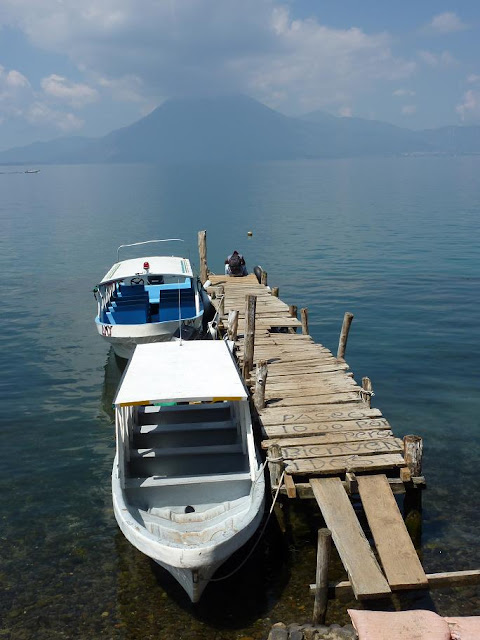Hello all, in the hunt to try to find a place to live, I haven't had much time to blog. I also went to check out some gold and silver mines...which for the half hour we were in the mines were "cool" and also very disturbing. I'll post photos of that tomorrow.
For now, here is a sneak peak at Lago Atitlan, where I plan to go to study for a week or two after leaving Xela. It's beautiful, to say the least.
Lake Atitlan is a highland lake surrounded by volcanoes. Panajachel is the largest town on the lake, which is also known as Gringolandia. The small shops and brightly colored buildings...along with a hostel with beautiful flowers, a comfy bed and a bright, clean bathroom, the experience in Panajachel wasn't bad. But, the aggressive vendors and insane cat calls were tough to take.
The reason to go to Lago Atitlan is not for Panajachel, obviously. It is for the lake and the volcanoes. The soft tranquility and fresh air could make any persons shoulders relax. For me, it was nature's way of giving me a shoulder rub!
Lago Atitlan sustains a dozen different pueblos, all of which survived around the lake speaking different languages and trading with each other. The locals are used to foreigners...as their neighbors across the lake and on either side of them spoke different languages, wore different clothes, and even looked a little different.
For all purposes, they are all different kinds of Maya, but here is Guatemala natives don't consider themselves a collective "Maya." They are either (predominantly) Tz'utujil, Kaqchikel, or Quiche.
Unfortunately, we were on the lake right around noon, so everything is washed out...and I haven't figured out how to change colors using Paint. The best part of the trip for me was being on the boat and seeing the insane Volcanoes rise out of the huge lake. None are active. They like to sleep, just like my boyfriend:) Love you Dave!
We made three rather short stops around the lake. The first...to tell you the truth, I'm not even sure of the name. We didn't actually go to the pueblo. We docked the boat and jumped in the water, which was hot as it seeped out of the rocks from the volcanic activity underground. It was so hot, my hand could only handle a mini-second finger dip. Hence, the water surrounding it was warm to cool. It was perfect to move my body and partake in the volcano's gift.
The above photo is a better look at our swimming area. Yes, I did question how healthy it was to swim in the lake...as most parts of the country has crazy kinds of parasites waiting for you to jump in. Everything I read said Lake Atitlan is a "go," ... with it being iffy in the rainy season because of all the runoff from farms. Luckily, we still have a month until the rainy season.
Our second stop was to check out the while church in the upper left side of the photo and to visit some weaving cooperatives. I believe this was San Antonio. It's been a slow season, so some women selling their goods were quite aggressive. They wouldn't take no for an answer and would follow you for blocks. Blocks. And blocks. Hence, I bought a beautiful green woven scarf for $1.25. Who will get it as a gift?
Weaving is both a job for women and men. Locals crank some of these scarves out in an hour. Some of the hand embroidered blankets take months to make. Silk and cotton in any color you want are available. Each pueblo has their own specific weave, so you can find different patterns in different places.
If you want to take a class and make your own, that's an option. If you want to request a certain patter with certain colors and return in a day or week or month, that's possible too.
And if you want to dress up like a local, you can do that too. No need to promise to pay either. It's just for fun. No, no, that's not me. It's a girl from Germany that also attends my Spanish School - Helena.
 Or you might see an albino women and think it is a gringo gone local, but then after doing a double take, it's actually a local. Note that all the women are wearing the exact same thing. That's the way it goes! Those are the weave and colors of San Antonio.
Or you might see an albino women and think it is a gringo gone local, but then after doing a double take, it's actually a local. Note that all the women are wearing the exact same thing. That's the way it goes! Those are the weave and colors of San Antonio. Taken from the white church, this photo exemplifies the interesting fuse of Maya and Catholic (or Evangelical) culture and religion around the lake.
Saturday, I'll post our stop off at Santiago de Atitlan, which hosts the second oldest church in Guatemala that played a crucial role in the civil war, as it was a refuge for fleeing Mayans.












No comments:
Post a Comment